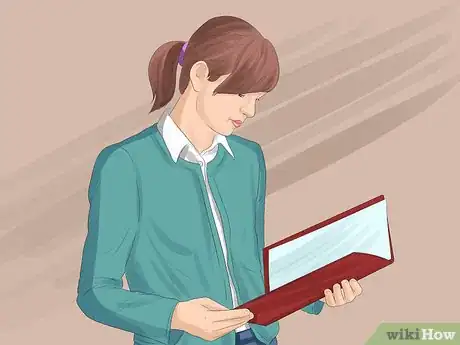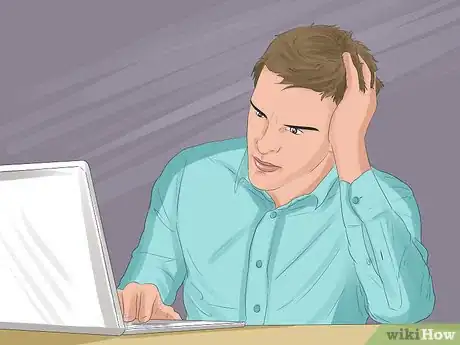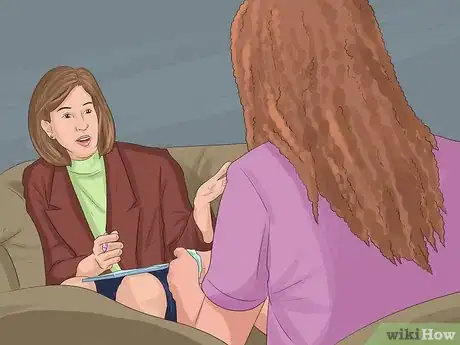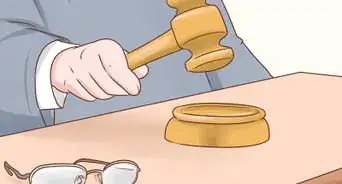This article was co-authored by wikiHow Staff. Our trained team of editors and researchers validate articles for accuracy and comprehensiveness. wikiHow's Content Management Team carefully monitors the work from our editorial staff to ensure that each article is backed by trusted research and meets our high quality standards.
There are 7 references cited in this article, which can be found at the bottom of the page.
This article has been viewed 51,085 times.
Learn more...
A homeowners' association (HOA) is a group of elected residents who own homes in the same development/community. This group is responsible for enforcing the rules and regulations agreed upon by the residents, and they exercise some authority over how property in the development is used. The leaders of a homeowners' association are elected to office by the rest of the residents in that development. Learning how to run a homeowners' association or start one from scratch can help you and other like-minded residents in your development manage your community and have a say in how land is used around your home.
Steps
Managing Your Homeowners' Association
-
1Understand how the HOA works. Whether you're new to an existing board or part of a new startup board in a recently-formed HOA, you'll need to learn how your association works. Every board member should understand his or her responsibilities and obligations, and the entire board should be familiar with the management plan that's been set in place for that HOA.[1]
- All board members are bound by the HOA's governing documents.
- No board member may exercise authorities that are not explicitly outlined in those documents, and all board members must adhere to the responsibilities established therein.
-
2Examine any existing policies before trying to make new ones. Many new board members become overly enthusiastic and eager to prove themselves. This often results in an overreach of powers or the introduction of flawed or unnecessary policies. Before you attempt to change a policy or introduce an entirely new one, make sure you familiarize yourself with the existing policies on that topic as they are currently written.[2]
- Even if a new policy is warranted, make sure you and the other board members collectively take your time to examine all the ins and outs of the proposed policy to ensure it is feasible and will be effective.
- Familiarize yourself with the previous boards that have served your community (if your development has had other boards in the past). Read through the minutes from their meetings and take the time to understand the history of your community and its past decisions.
Advertisement -
3Make transparency a priority. A homeowners' association board must be completely transparent in all its decisions and proceedings. Transparency is the only thing that will give the homeowners confidence and trust in the board. Talk about issues your community faces, invite feedback from other homeowners, and hold open public discussions on HOA proposals for your community.[3]
Running a Meeting
-
1Organize an owners' meeting. The owners' meeting opens the board up to input from homeowners and unit owners in that development. Owners' meetings typically address board elections, budgetary approval/amendments, amendments to the HOA's governing documents, and other factors that involve the homeowners. Depending on where you live, there may be certain requirements about the frequency of meetings. For example, in Colorado, a general homeowners' or unit owners' meeting must be held at least once each year.
- Each state may have specific requirements about how far in advance an owners' meeting is scheduled. All owners must be notified of the upcoming meeting within that time frame.
- Many HOAs are required to post a physical notice about upcoming meetings in a visible community area. The HOA may also send out email notifications or mailed letters of correspondence to the development's homeowners.
- All notices and correspondences should include the date, time, and place of the meeting, as well as any items scheduled to be on the agenda that day.
-
2Convene a board meeting. Board meetings should be open to all association members, or a designated representative if a given member cannot be present. All HOA residents should be permitted to see the agenda for a board meeting, and the HOA must adhere to the association's bylaws that govern board meeting notifications.
- In order to ensure a productive board meeting, it's best to prepare an agenda and stick to it during the meeting.[4]
- The board must stick to items that are already on the agenda and may not introduce new items without prior review.
- The agenda should ratify the minutes from the last board meeting, discuss unresolved ("old") business, and discuss new items up for discussion or vote.
- Boards may also wish to have an open forum for homeowners during the meeting to ensure that residents have a say in their HOA's government.[5]
- Make sure all board members follow an agreed-upon code of conduct. This may include following parliamentary proceedings during the meeting, allowing homeowners to watch the board conduct business, and other procedures to ensure a smooth and productive meeting.
-
3Call a special meeting. Special meetings may be called to address emergencies and other time-sensitive issues. A homeowners' or unit owners' special meeting may be called by the HOA president, a majority of the HOA's executive board, or by home/unit owners with a certain percentage (outlined in the bylaws) of the association's votes.
Organizing a Homeowners' Association From Scratch
-
1Compose your HOA bylaws. The HOA's bylaws are a functional set of rules for the association's day-to-day management. It should include information on the various types of meetings that will be held, as well as election and removal proceedings for new or outgoing board members.[6]
- The requirements for an HOA's bylaws will vary from one state to another, though some things should remain uniform across all HOA bylaws.
- The bylaws should require that the HOA can buy back stock/membership interest from homeowners who are not permanent residents of the community.[7]
- Any stock/membership interest bought back by the HOA must be sold to new members at the same price.
- Two-thirds of resident owners/shareholders must vote in favor of an amendment in order for the HOA's bylaws or articles of incorporation to be revised.
-
2Write the articles of incorporation. The articles of incorporation lay out the name of your HOA, the principal office address, and the name/address of the registered agent for your HOA. This document establishes the purpose of your HOA, as well as its governing powers. In many states the articles must be filed with the Secretary of State in order for the HOA to be incorporated as a non-profit entity.[8]
- The articles must establish in writing that the homeowners' association is organized for non-profit purposes, and that no individual associated with the HOA (as a corporation) will see any private gain.[9]
- In order to qualify as a non-profit organization, the HOA must also cite the home state's tax code that governs non-profits.
- The articles should also incorporate a limitation clause, which states that the HOA will not utilize powers that are not declared in the governing documents.
- The HOA may choose to incorporate the features of the articles of incorporation into the bylaws, or the HOA may create and adopt the articles as a new and independent document.
-
3Draft your HOA's declaration of covenants, conditions, and restrictions. An HOA declaration is a separate document that details the mandated appearance of all governed properties, any restrictions on property use, and the property maintenance obligations of all residents. The declaration may also establish any necessary requirements regarding common expense assessments for residents, and should be filed with the county clerk's office.[10]
- Typically, any private property that affects the structure or overall appearance of a home (including the yard, roof, and outside walls of a home) is considered association property. As such, it is subject to the declaration's mandates for appearance and upkeep.[11]
-
4Pass your HOA's rules and regulations. The rules and regulations lay out what a board member's authority is within that development, and should also state what potential consequences may come with a given infraction of the rules. For example, if a board member has the authority to give notice and subsequently inspect a homeowner's property to check for rule infractions (like pets, maintenance needs, etc), those powers must be plainly stated in the rules.[12]
- As part of the rules and regulations, homeowners must be informed of when and how to challenge a given rule. There must also be a fair process for arguing against an infraction citation, with the homeowner given a chance to tell their side of the story.
-
5Set a budget and dues payment schedule. As your homeowners' association grows, you'll need to establish how much homeowners must pay each month in dues to the HOA. Other budgetary obligations for homeowners may include assessments for maintenance, significant repairs, property upgrades, and structural improvements. However, the HOA's budget must adhere to state law when it assesses and quotes the financial obligations of its homeowners.[13]
- Talk to a real estate lawyer in your community to determine what is fair and legal to charge homeowners in your development.
- You can find real estate lawyers in your area by searching online or in a local phone book.
-
6File with the Internal Revenue Service (IRS). Many HOAs file with the IRS to receive tax benefits, such as excluding exempt-function income from the HOA's reported gross income. In order to receive these benefits, the HOA must complete and file Form 1120-H with the IRS. This form must generally be filed before the income tax return due date.[14]
- Form 1120-H can be downloaded and printed from the IRS website. You can also place an order online through the IRS website to have the necessary forms mailed to your HOA.
- Requests for mail ordered forms should be completed by the IRS and received by the HOA within 10 business days.
Community Q&A
-
QuestionWhat do I do if someone is making rules in the HOA to benefit themselves?
 Community AnswerThat is against policy. Policy must be agreed upon by the BOD, then the HOA.
Community AnswerThat is against policy. Policy must be agreed upon by the BOD, then the HOA. -
QuestionWill other rules be voided if the HOA allows one homeowner to break a rule?
 Community AnswerThe HOA cannot do that legally. If it were to do that, it could get in trouble by the city or state.
Community AnswerThe HOA cannot do that legally. If it were to do that, it could get in trouble by the city or state. -
QuestionHow do I set up new leadership of an HOA that is now run by a paid management company?
 Community AnswerSet up a special HOA meeting and let the homeowners know they will be voting for new board members - president, vice president, treasurer and secretary. Find “take charge types” or see who would like to volunteer. Then vote. Read your bylaws to understand the duties of each elected position and how they work together.
Community AnswerSet up a special HOA meeting and let the homeowners know they will be voting for new board members - president, vice president, treasurer and secretary. Find “take charge types” or see who would like to volunteer. Then vote. Read your bylaws to understand the duties of each elected position and how they work together.
References
- ↑ http://www.hoaleader.com/public/404.cfm
- ↑ http://www.hoaleader.com/public/404.cfm
- ↑ http://www.hoaleader.com/public/404.cfm
- ↑ http://hoabrief.com/2012/06/10/running-an-effective-board-meeting/
- ↑ http://hoabrief.com/2012/06/01/what-should-be-on-your-agenda/
- ↑ http://www.cohoalaw.com/your-governing-documents-is-your-community-built-on-a-solid-foundation.html
- ↑ https://www.ftb.ca.gov/forms/misc/1028.pdf
- ↑ http://www.cohoalaw.com/your-governing-documents-is-your-community-built-on-a-solid-foundation.html
- ↑ https://www.ftb.ca.gov/forms/misc/1028.pdf
- ↑ http://www.cohoalaw.com/your-governing-documents-is-your-community-built-on-a-solid-foundation.html
- ↑ https://www.ftb.ca.gov/forms/misc/1028.pdf
- ↑ http://real-estate.lawyers.com/homeowners-association-law/ccrs-and-other-documents.html
- ↑ http://real-estate.lawyers.com/homeowners-association-law/ccrs-and-other-documents.html
- ↑ https://www.irs.gov/pub/irs-pdf/i1120h.pdf













-Step-11.webp)




















-Step-11.webp)




































